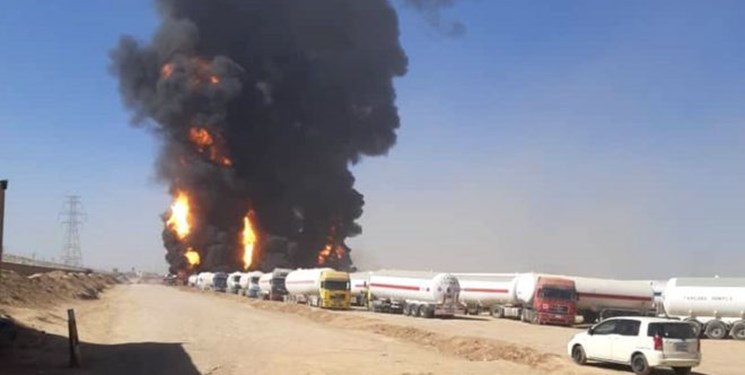February 26, 2021

A huge series of explosions and fires struck a crowded parking lot full of tanker trucks trying to get the paperwork done so they could enter Afghanistan.
Hundreds of trucks blew up at the Afghan customs station just over the border from Iran. The blasts and fire also destroyed two pylons bringing Iranian electricity into Afghanistan, cutting off power to 60 percent of Afghanistan’s Herat province.
Iranian media uniformly said no one was killed. That seemed impossible given that the customs house was in the midst of the explosions. The International Organization for Migration (IOM), a UN agency with staff at the border to help returning Afghan migrants, issued a press release saying “at least 40” people were killed. Iranian news reports put the casualties at as many as 60 injured. The governor general of Afghanistan’s Herat province, Walid Qatali, said only 17 people were injured and only five of them seriously enough to be hospitalized.
The IOM later issued another press release that made no mention of any deaths and spoke of 17 injured, quoting Afghan officials.
The Iranian media uniformly said the cause of the first explosion was unknown and under investigation. The IOM press release said the initial explosion was sparked by “small arms fire.” It didn’t say who did the firing or why. In its second release, the IOM again said the fire “was sparked by small arms fire.”
But the Herat Chamber of Commerce said a strike by truckers protesting increased Afghan taxes was in its second week, which might explain gunfire.
Afghan officials said there were some 2,500 vehicles, including tankers, parked there while their drivers tried to get customs documents processed. When the first explosion blew up the first tanker, drivers rushed to move their vehicles farther away and out of danger. Iran allowed any who approached to enter Iran. Many news reports said 500 trucks were destroyed.
Two weeks after the conflagration, no one had yet announced a count of the burned-out vehicles.
Nor has anyone yet reported how many of the trucks destroyed were Iranian. But it is likely most, if not all, were Iranian, since they were carrying Iranian fuel and other products into Afghanistan. Afghanistan does not have any refineries and so must import all its oil products. The United States has given Afghanistan a waiver from US sanctions so it can import Iranian fuel products.
The fires started about 1 p.m. Iran/Afghan time on February 13. According to NASA, two explosions, at 1:10 and 1:42 were large enough to be picked up by satellites overhead. It isn’t known how many trucks blew up and how many just burned. Heavy winds the second day of the fire helped to spread it.
The Associated Press said the fire spread that day across the border to the Dogharoon customs post on the Iranian side of the border. But Iran denied that and satellite photos taken later do not show any damage anywhere near the Dogharoon post. In fact, much of the sprawling Afghan Islam Qala border post remained intact.
But the fire was too big for the Afghan fire units at the border, so Iran sent trucks into Afghanistan to help.
Various officials told reporters the fires were extinguished February 13, then February 14, then February 15. But others said the fires continued until February 16—and even then firefighters were pouring water on smoldering piles to prevent full-fledged fires from erupting again.
The two border posts are in the middle of nowhere. There is no population center anywhere nearby. The city of Herat, capital of Afghanistan’s Herat province, lies 120 kilometers (75 miles) east of the border post. And Mashhad is even farther away in the other direction.
The border crossing was closed until February 18, five days after the fire erupted. It then re-opened on a very limited basis, with only one scale in use and only trucks with perishable goods being processed. This crossing has long handled the vast majority of commercial traffic between the two countries as the other two border crossings go into areas where the Taliban are active.